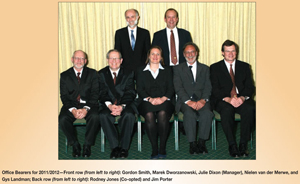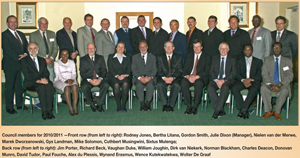Services on Demand
Article
Indicators
Related links
-
 Cited by Google
Cited by Google -
 Similars in Google
Similars in Google
Share
Journal of the Southern African Institute of Mining and Metallurgy
On-line version ISSN 2411-9717
Print version ISSN 2225-6253
J. S. Afr. Inst. Min. Metall. vol.111 n.9 Johannesburg Sep. 2011
PROCEEDINGS
Proceedings, 114th Annual General Meeting, 2011
The 114th Annual General Meeting of The Southern African Institute of Mining and Metallurgy was held at The Country Club, Johannesburg, Napier Road, Auckland Park on Thursday, 11 August 2011.
Welcome
The President extended a special welcome to the guests and representatives of our sister institutes and other associations, and also to recipients of awards, senior members of industry, Honorary Life Fellows, past-presidents, our members and other guests, among them the following:
F. Cawood, President, Institute of Mine Surveyors of South Africa
C. Roode, President, Mine Metallurgical Managers' Association of South Africa
M. Cresswell, Chairman, South African Coal Processing Society
A. Hay, Immediate Past President, South African Institute of Electrical Engineers
L. Gardner, President, South African National Institute of Rock Engineers
J. Krynauw, President, The Geological Society of South Africa (GSSA)
Past-presidents attending
| Richard Beck | Rod Pickering |
| John Cruise | Robbie Robinson |
| Roger Dixon | Mike Rogers |
| Frank Egerton | Dick Stacey |
| Andrie Garbers-Craig | Oskar Steffen |
| Rick Mohring | Willem van Niekerk |
Minutes
The minutes of the previous Annual General Meeting, which were published in the September 2010 issue of the Journal, and sent to all members, were confirmed.
Obituaries
The President announced the death, during the year, of the following members:
Honorary Life Fellow
S.P. Botha, J.K.E. Douglas, C.S. Macphail
Life Fellow
E.H.D. Carman
Fellows
A.R. Dykes, J.W. Oberholzer
Retired Fellows
J.R.F. Handley, P.J. Ryan, H.A.G. Slater, P.J. van der Walt, C.J. van Niekerk
Members
S.B.Chantler, J.M.A. Geldenhuis, S.J.J. van Heerden
Retired Members
J.L. Alderton, A.E. Hall, W.H. Stheeman, D.W Stofberg
In memory of the deceased and in sympathy with the bereaved, all rose and observed a moment of silence.
Honorary Fellowship
No award was made this year.
Brigadier Stokes Memorial Award
Marek Dworzanowski: The Brigadier Stokes Memorial Award was instituted in 1980 to commemorate the outstanding contribution to the South African mining industry made by Brigadier R.S.G. Stokes, an Honorary Life Fellow and pastpresident of this Institute. The award is made to an individual for the very highest achievement in the South African mining and metallurgical industry. It gives me great pleasure to announce that the award for 2011 is to be made to Barend Christiaan Alberts.
Marek Dworzanowski called upon Oskar Steffen, to read the citation:
Barend Christiaan Alberts obtained his BSc Eng degrees in Mining and Agriculture from University of Pretoria in 1963 and 1965 respectively.
I will never forget Ben Albert's presidential address in 1987 on the coalfields in the Waterberg. It was a monumental work, highly informative, and projected a vision for the future. It is no coincidence that Ben's career was focussed on the fundamental commodities of coal and iron ore that form the cornerstone of a country's industrialization. Add to that the agricultural sector and we find Ben's second degree is agricultural engineering.
Ben grew up at Thabazimbi Iron Ore Mine, later started his career there, and Thabazimbi became part of his portfolio for approximately 30 years. I know his father only from the picture that hangs on the wall of the Thabazimbi boardroom, but am informed that in this case the apple did not fall far from the tree. Ben's first job as mine manager was in charge of 2 miners and 50 labourers, who wheelbarrowed the coal to the shaft in his beloved Waterberg coalfield. His early career found him managing Grasvally Chrome mine for five years. Afterr that he joined Amcor/Samancor to brush up on his project planning skills and feasibility studies for a platinum mine at Elandskuil.
Ben joined Iscor again in 1975. Through his in-depth understanding of coal geology, mining, and beneficiation, Ben has as his legacy the massive Grootgeluk mining and beneficiation complex. This however was no cake walk. He was proud of being the leader of the team that planned and built the Grootgeluk Coal Complex with commissioning targeted for 1978. However, Iscor ran out of funds during the energy crisis in 1975, but the team perservered and when Iscor obtained money via a lease they completed the construction and commissioned the mine in 1981. Grootegeluk is now the diamond in Exxaro's crown, and is still the only major greenfield project ever commissioned in the Waterberg coalfields.
Ben, or Baas Ben as he was affectionately know, headed up the Iscor Mining assets with the creation of Iscor Mining and was appointed managing director. All coal procurement functions resided within Iscor Mining and formed part of his accountability. Iscor Mining also managed and operated five collieries, with the rest of his portfolio including the Sishen and Thabazimbi iron ore operations, zinc and tin operations, as well as a number of quarry operations. A huge portfolio of assets.
During the difficult years in the resource industry at the beginning of the 1980s Iscor gave official notice of the closing of Sishen Export Mine. Ben's team was again challenged. The government set up a panel of experts including members from the DTI, Transnet, and Iscor to investigate all possible alternatives to save the project. The Iscor team, assisted by a certain Jan van den Berg, presented a plan that made it possible for the project to continue and it was accepted. Sishen is now one of Anglo American's most important income generators with a projected life of over 40 years.
Ben also rates amongst his most rewarding endeavours the graduate training programme that was developed within the Iscor establishment.
Ben played a pivotal role in the separate listing of Iscor Steel and Kumba Resources to form the current entities of ArcelorMittal, Kumba Iron Ore, and Exxaro Resources.
When Ben retired from his corporate environment, he became a sought-after independent consultant. His involvement with the Phoenix Project at Thabazimbi and the Delmas coal project has provided Ben with the challenges that he had become accustomed to during his career.
As a senior industry consultant Ben has advised large players such as ArcelorMittal and Transnet Freight Rail, and worked closely with Kumba Iron Ore on a low grade iron ore project at Thabazimbi. Through an association with Deloitte and Touche, he has also assisted Xstrata Coal with their own strategies.
Ben has an intimate understanding of iron ore sales, coal sales and procurement, iron ore and coal qualities, contract negotiations, prices, mining, the Southern African iron ore and coalfields and the iron ore and coal industry in general.
It is also notable that Eskom worked closely with Ben when the Matimba Power Station was built in the Waterberg, and that he has a good understanding of Eskom's requirements.
Ben is also a great lover of nature, with a particular interest in trees. During the development of the Grootegeluk Complex, all trees in the proposed township were identified and charted and no trees could be removed without the authority of the environmental officer, who took his instruction from Baas Ben. Water supply pipelines were re-routed to avoid unnecessary tree removals. Clearly there is a passion when a man walks the talk.
A memorable visit was the People to People tour to the USA arranged by Ben for SAIMM members. We visited many mining operations, including many coal mines, and everything worked like clockwork, as one would expect from the management skills of Ben and Ansie.
Ben has also served on numerous committees:
➤ Chairman and member of the Council of the University of Pretoria
➤ Chairman of Mining and Industrial Chamber of AHI
➤ Chairman of Tuks Alumni Association
➤ Chairman of Tuks Mining Alumni Association.
He also initiated the Advisory Committee to the Mining Department.
He has also excelled in the field of sport. Being a formidable rugby scrummager, he played for the first team in his school, university, Northern Transvaal, South African Universities, Gazelles team to Argentina, and South African Barbarians. He does accept that he failed to make the grade in high jump ang pole vaulting.
Ben's marriage to Ansie in 1964 is proof of his good judgement of people. They had five children (he blames it on too many night shifts as a miner) and adopted two more. Sadly they lost their daughter, Mawiet, in a car accident when she was 20. Today Ansie runs the family farm in Piet Retief district and Ben provides moral support but no consulting advice.
Ben is a mining engineer extraordinaire! He has seen difficult times and has worked with vigour and foresight to achieve success. He possesses that intuitive instinct of what is achievable and is a great motivator of people. He fully grasped the motto that people, correctly motivated, make the difference. Ben justly deserves recognition by the SAIMM for his contribution to the mining industry in the form of the Brigadier Stokes Memorial Award..
Ben Alberts: Mr President, fellow members of the Insitute, ladies and gentlemen.
I retired from active duty (1999–2011) 12 years ago, but have not stopped working actively in the mining industry up until now. My present occupation is that of a gravedigger— digging up mining retirees, tickling their toes and spotting any movement, calling them up to participate in interesting and rewarding jobs as members of feasibility teams. In the mining environment there is currently a great need for experienced mining men to assist with feasibility studies and also sorting out production problems.
I have over the last few years assisted two teams to complete two bankable feasibilities studies—one for iron ore and one for coal. I enjoyed every minute of it. My job designation presently is Oom Ben— a title I really treasure. When Gys phoned me about this award I was really taken by surprise because of the status of the award, with Mr Harry Oppenheimer being the first recipient. Having played some rugby in my life, I maintained that if players are allowed to select a team, you will be guaranteed of getting the best team. I therefore, feel honoured because of this recognition by my peers in the mining industry. Thank you!
Rugby taught me many lessons because I maintain that you can equate every tough match as the equivalent of a career in the industry. You get to know who you can rely on and also learn that you have to stand up every time you lose and give everything again, otherwise you will never make it in the industry.
This philosophy helped me to commission Grasvally Chrome Mine, keeping Sishen Export Mine running, getting Rosh Pinah Zinc Lead Mine contractual problems sorted out, and commissioning of Grootegeluk Coal Mine.
By saying 'helped me', I actually mean 'us', because I was fortunate to work for experienced, successful, and visionary supervisors. Mr Hans Coetzee, Kurt Rümelin, Floor Kotzee (the person that taught me the most and the person that right-sized Iscor), Derek Keys (my model director), Warren Clewlow, Marius de Waal and the mining team consisting of Johan Deetlefs, Jan Grimes, Osche Esterhuyzen, Chris Wessels, Con Fauconnier, Kowie Strauss, Johan Moolman, Chris Labuschagne, Hennie Nel, and Johan Coetzee.
On the mining technical side I have to mention Oskar Steffen, Horst Wagner (two close friends), Kay Pincock (Pincock, Allan & Holt) an experienced mining production engineer, and Alan Bauer (explosives engineer, Canada). Colleagues in industry. Here I want to mention Dave Rankin. We had to close a number of collieries as a result of right sizing of Iscor. I think of Springbok Hope, Springbok Main, and Indumeni.
Reflecting on my career I can without fear of contradiction say that I enjoyed every minute of it in coal, chrome, and iron ore mining production and as part of a mining division producing dolomite, quartzite, tin, zinc, lead, and heavy minerals.
The privatization of Iscor gave me a lot of satisfaction because it removed a hurdle set by the Iscor Act that only the minerals needed in the iron and steel industry could be mined by Iscor's mining division. The privatization also gave us the opportunity to implement the strategy that we developed before privatization (to utilize the opportunity offered by the new business environment) to create a new mining house, Kumba Resources, which later became Kumba Iron Ore and Exxaro.
The other cause for job satisfaction was being a member of a small team that 'saved' the Sishen Export mine from being closed down. Looking at present performance of the mine it is incomprehensible that the feasibility of the mine was ever in question.
Grootegeluk Coal Mine was the other, and to me the greatest, cause for satisfaction. We ran out of money to build the mine in 1975 but managed to convince our board and Eskom about the value of the mine, which if evaluated today is the cornerstone of Exxaro and unlocked South Africa's most important coal resource for the future.
Receiving this auspicious reward I cannot omit thanking my wife and children for their support (they are all present tonight) and for sacrifices made, like moving house eleven times in thirteen years.
I would like to say that all the members of the SAIMM can feel proud of the role our Institute has played in southern African and world mining.
In closing - thank you Mr President, ladies and gentlemen, and allow me the opportunity to wish the Institute everything of the best for the future.
Presentation of awards, medals and certificates
Marek Dworzanowski announced the following awards, medals and certificates, which were presented by Gys Landman.
50-year Membership Awards
(with effect from 1 July 1960 to 30 June 1961)
➤ R.E. Robinson
➤ B. Moore
➤ C.T. Shaw
➤ H. von Rahden
➤ L. van den Bosch
➤ A.G. Joynt
➤ C. Roper
➤ R. Hemp
➤ M. Wishart
Silver Medals
Silver Medals were awarded to:
H.T. Chiwaye and T.R. Stacey, for their paper published in the October 2010 issue of the Journal entitled:
'A comparison of limit equilibrium and numerical approaches to risk analysis for open pit mining'.
and
B.P. Watson, T.R. Stacey, and J.S. Kuijpers, for their paper published in the October 2010 issue of the Journal entitled:
'Design of Merensky Reef crush pillars'.
Presentation of Student Prizes
Marek Dworzanowski announced the student winners of the SAIMM Prestige Prize and Gys Landman presented the awards to the students adjudged by their departments to be the best final-year students in 2010:
University of the Witwatersrand
| Mining | Ms P.N. Neingo |
| Metallurgy | K. Molabe |
| Best final year student in the faculty of any engineering discipline (chemical) | A.J. Paverd |
| Best final year student in any faculty in the discipline of mining or metallurgy | Ms P.N. Neingo |
University of Pretoria
| Mining | R. Aipanda |
| Metallurgy | A. Muller |
| Student Dissertation | X. Maree |
University of Johannesburg
| Mining | M. Nyarela |
The following SAIMM student prizes were presented at the Western Cape Branch AGM on 4 August 2011.
University of Cape Town
| Chemical Engineering | H. Nyakunuhwa |
University of Stellenbosch
| Process Engineering | C. Cilliers |
Cape Peninsula University of Technology
| Chemical Engineering | W. du Plessis |
Annual Report and Accounts
The Honorary Treasurer, Jim Porter presented the financial statements.
While writing this year's financial report I found it all too easy to get lost in the business of analysing the numbers; trying to anticipate questions, identifying trends, looking for risks. But the real story behind these numbers is actually all about people: the SAIMM staff, your Council, our sponsors, and in particular our members. It is a story that I am delighted to be able to tell because we all like a good success story and it is a real credit to all those in the cast.
So, once upon a time in a treasurer's office far far away ...
The 2010 to 2011 financial year saw a number of performance records set in the key areas of:
➤ Total assets: R27 106 868 (up 33%)
➤ Total reserves: R25 077 818 (up 32%)
➤ Total revenue: R21 062 185 (up 112%)
➤ Income from conferences: R 17 713 742 (up 185%)
➤ Cost of sales: R13 723 262 (up 67%)
➤ Operating expenses: R4 823 471 (up 204%)
➤ Operating surplus: R2 515 452 (up 2 704%)
➤ Total surplus: R5 900 497 (up 130%).
This record financial performance of the SAIMM in the year under review is the result of key decisions made cumulatively in recent years. These decisions have been about investments: investment in the quality of our conferences and publications, investment in recruiting and developing our staff, investment in expanding our membership footprint throughout Southern Africa, and decisions about how to make our excess of income over expenditure work for the Institute. Therefore, considered and well implemented decisions by your elected Council Members have built, over several years, a momentum of consistent financial results.
I would like to make some further comments of explanation to the abovementioned key results:
The balance sheet shows that non-current assets rose by an impressive 52% to R18 790 094 (R12 368 945) with current assets increasing marginally to R8 316 774 (R7 981 978).
Growth is largely as a result of our investment activities growing by 54% to R18 017 773 (R11 701 438). It is worthwhile noting that the total investment growth of R 6 313 335 is made up of:
➤ Fair value adjustment (42.2%)
➤ New investments (54.0%)
➤ Other (3.8%).
The 32% jump in reserves is attributable to the increase in accumulated surplus from the operating activities as the reserves held in the various SAIMM funds (R4 191 930) have remained static, with the exception of earned interest of R180 514.
Turning to the Income Statement (as at 30 June 2011), we can report that total revenue rose to R21 062 185, the highest turnover in our history and driven by several large and successful conferences. It is of some concern that revenue from our Company Affiliates has fallen by 47%, but some of this is offset by a 16% increase in revenue from new members. However, Company Affiliate organizations are a cornerstone of the SAIMM and this will require investigation.
Cost of sales has increased substantially due, in large part, to additional spending on the larger conferences and capacity to manage the workload. I am sure that you will agree that the increase in CoS of 67% is justified against the 185% growth in conference revenues. In addition, operating expenditure or overheads has increased in order to build the capacity to handle the additional workload. For example, of particular note is the fact that staff and Office Bearers now need to allocate time for travelling to support and mentor the newly established Regional Branches.
The net result is a surplus of R5 900 497 in comparison to the previous years' R2 564 365.
In my view there are three areas that require specific commendation.
Firstly, the performance of our Technical Programme Committees. Through the efforts of the Conference organizers we saw a 26% increase in the physical number of delegates attending our conferences, which translated into a 30% rise in revenues from all conference activities.
Secondly, strict credit control management. The professional manner in which our Conferencing and Membership Departments now manage the collection of payments due by delegates, sponsors, and members has impacted positively on cash flow. The value of unpaid debtors older than 60 days is at an all-time low of just 3% of the total invoiced value. Ladies and Gentlemen—this is an excellent business!
Thirdly, the hard work that has gone in to restructuring our financial discipline and management. This has had a considerably positive impact on cash flow, and has enabled us to make more frequent contributions to our investment fund to the extent of R3 412 384 for the year.
As I mentioned at the beginning, it is the activities of people in their various roles that have written this year's story. The enthusiasm of members in the new Regional Branches, the dedication of our hard working staff, and the time given by our Council members and Branch organizations. It is unfortunate that these accolades for our staff are only recognized once a year at the AGM.
At this point I think that it is prudent to caution our members that the performance of last year is not likely to be repeated. The reasons are that there are not as many large events in the year ahead, and also it is very unlikely that we will see a repeat of the growth in our investment portfolio. Of course the SAIMM is a non-profit organization; our purpose is not to grow a balance sheet. Having said that, it has been a very clear objective of the Institute for several years to build its investments and cash reserves to the point where we have a very secure and stable future. It is now time to consider how we can make these resources work for the Institute and its membership in alignment with our Constitution.
Thank you to Alf Bettoni, our accountant; Robert Kitching, our auditor; Julie Dixon, our Manager, and all of the wonderful cast in this story for assisting me in my first year as your Treasurer. It is a great honour for me and lastly thanks again to John Cruise, the master storyteller ... I have a long way to go.
Office bearers and Members of Council for 2011/2012
Gys Landman announced the office bearers for the ensuing year, elected by the retiring Council in accordance with Clauses 3.2 and 3.3 of the Constitution:
| President | J.N. van der Merwe |
| President-elect | G.L. Smith |
| Senior vice-president | M. Dworzanowski |
| Junior vice-president | J.L. Porter |
| Immediate past-president | G.V.R. Landman |
| Honorary treasurer | J.L. Porter |
In terms of the election of ordinary members of Council (bylaw 3.2.7), there is a letter from the scrutineers stating: 'We have to report that we inspected the nomination papers for members of Council for the 2011/2012 session, and have found that the ballot papers sent out to Corporate Members of the Institute were in order. As a result of our scrutiny, we find that the following members have been elected (in alphabetical order):
| N.G.C. Blackham | A.S. Macfarlane |
| C.R. Deacon | M.J. Mothomogolo |
| J.J.L. du Plessis | D.D. Munro |
| P.A.P. Fouche | C. Musingwini |
| M.F. Handley | M.H. Solomon |
| R.T. Jones | D. Tudor |
| W.C. Joughin | D.J. van Niekerk |
In terms of Clause 3.2.11 of the Constitution, the chairmen of the branches are as follows:
| Johannesburg | V. Duke |
| Namibia | B. Litana |
| Pretoria | W. De Graaf |
| Western Cape | R.D. Beck |
| Zambia | S. Mulenga |
| Zululand | W. Erasmus |
| Zimbabwe | W. Kutekwatekwa |
These chairmen will be ex-officio members of Council.
The following past-presidents have signified their willing ness to serve on Council for the ensuing year:
| R.D. Beck | S.J. Ramokgopa |
| J.A. Cruise | T.R. Stacey |
| N.A. Barcza | F.M.G. Egerton |
| R.P. Mohring | W.H. van Niekerk |
| J.R. Dixon | R.G.B. Pickering |
| M.H. Rogers | A.M. Garbers-Craig |
Gys Landman thanked those past-presidents, who indicated that they cannot serve on Council for the next year, for all their time, effort and dedication in the past.
He also thanked past-presidents for their continued support. He congratulated all those elected, and thanked those who agreed to serve another term of office.
Election of auditors and honorary legal advisers for 2011/2012
Gys Landman proposed and it was agreed, that R.H. Kitching be reappointed as auditor for the coming year and that Van Hulsteyn, Attorneys, be reappointed as honorary legal advisers.
Induction of President
Gys Landman introduced the new President, J.N. (Nielen) van der Merwe, and then called upon Marek Dworzanowski to read his curriculum vitae.
Nielen was born in 1947 on the property of the Durban Navigation Colliery (DNC), where his grandfather was a miner. His father was a writer/journalist and the family lived in several places including Koffiefontein, which was the mecca of Afrikaans magazine publication at the time when he first went to school there.
The family later moved to Boksburg where Nielen completed his schooling at the Hoërskool Voortrekker, and where he was Head Prefect.
After school Nielen enrolled for a BSc Mining Engineering degree at the University of Pretoria. During that time he obtained his first mining qualification at the ERPM mine, an Onsetter's Certificate. Prior to graduating he served on the Students Representative Council.
Following the initial production training period as a stoper at the West Driefontein Gold Mine, he was seconded to the Rock Engineering Department as part of the compulsory periods in service departments. There he found the opportunity to perform mining engineering as opposed to production management, and never looked back.
He later joined General Mining at the Buffelsfontein Gold Mine and eventually, after the merger with Union Corporation to become Gencor, got involved in the rock engineering of a number of gold, platinum, asbestos, and coal mines. During that time he obtained a MSc (Engineering) degree from the University of the Witwatersrand. He founded the Trans-Natal (now BECSA) rock engineering department, where Coalbrook in particular played a major role in his affinity for coal mining.
Nielen then moved to Sasol for more difficult coal rock engineering conditions at Sigma Colliery and also the Secunda Collieries. During this time he completed a PhD degree part time during evenings, weekends, and holidays, again at the University of the Witwatersrand under the guidance of Professor Sandor Budavari.
Following brief spells with the ITASCA consulting group and the CSIR's division of Miningtek, he joined the University of Pretoria as Head of Mining Engineering. His first retirement was from that position, after which he became involved with the CIC Energy group to plan coal mines in Botswana.
Following his second brief retirement, he is now back in academia and occupies the Centennial Chair of Rock Engineering in the School of Mining Engineering at the University of the Witwatersrand.
Nielen was President of the South African National Institute for Rock Engineering for a number of terms and was instrumental in transforming the association into an Institute. He moved on to become the first African to be President of the International Society for Rock Mechanics and after his term expired, he was elected President of the Federation of International Geo-Engineering Societies, representing around 40 000 geo-engineering specialists globally from four international societies, a position he holds today. He is also chairperson of the Advisory Committee for the United Nations International Atomic Energy Association Network for Uranium Production Education and Training.
Nielen is passionate about rugby, Italian opera, and good food.
He considers himself fortunate to have the support of his wife, Hantie. They have three children, Melani, Hein, and Nielen; and also a grandson, Niel.
His strongest ambition now is to serve the SAIMM well and eventually to succeed at retirement.
Presidential Address
Nielen van der Merwe then presented his presidential address entitled: Future of the South African mining industry and the roles of the SAIMM and the universities, which is reproduced elsewhere in this edition of the Journal.
Vote of thanks
Gordon Smith, gave the vote of thanks.
Closure
The meeting closed at 18:55. ◆
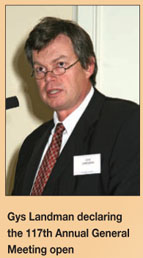
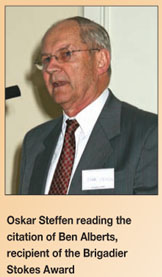
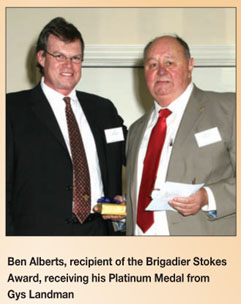

50-year Membership Awards
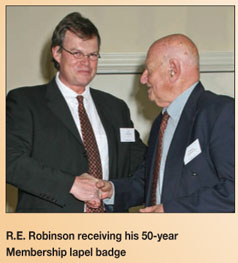
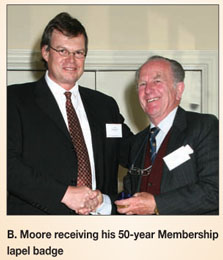

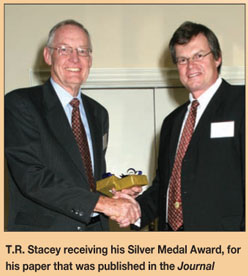
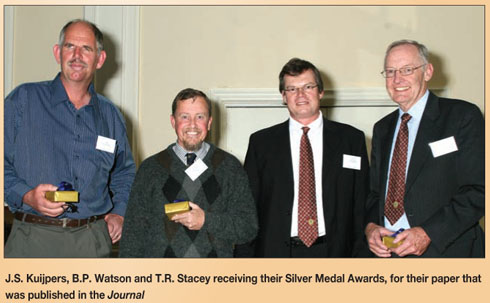
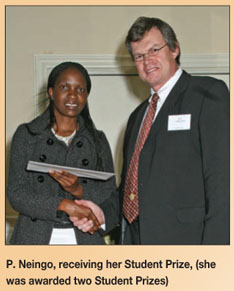
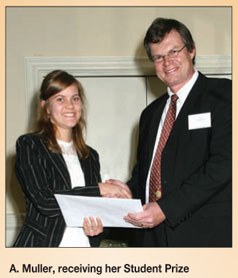
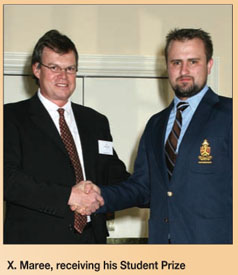
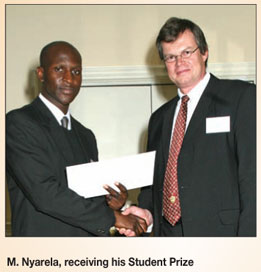
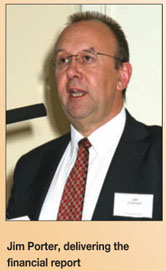


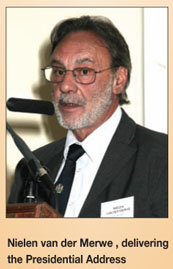
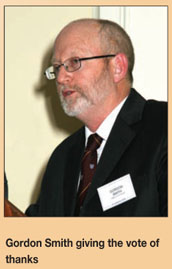
Office Bearers for 2011/2012
Past presidents of the SAIMM with the newly inducted president, Nielen van der Merwe
Council members and Branch Chairmen of the SAIMM
Members and their guests at the cocktail party
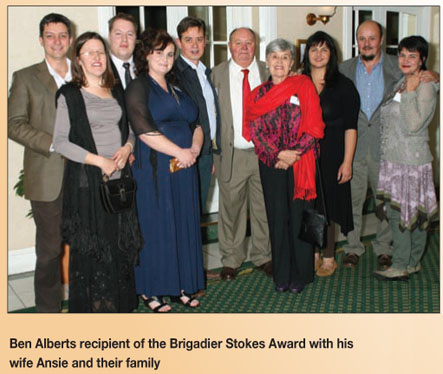
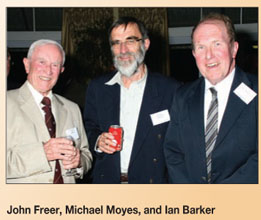
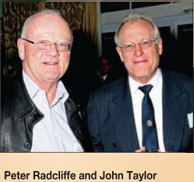
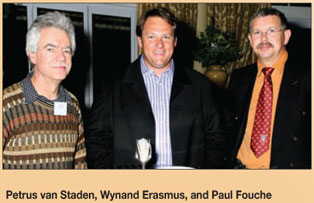
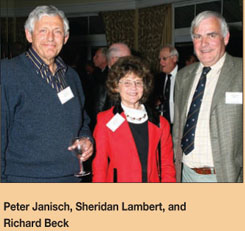
University students enjoying the cocktail party after the AGM














